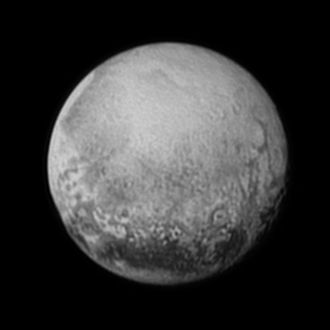
Until this week, the picture above was the best photo anywhere of Pluto, the (former) planet at the end of the solar system. NASA’s New Horizons probe will, on Tuesday and Wednesday, make its closest approach to Pluto, coming within 8,000 miles. (The planet is, at its closest, nearly 3 billion miles from Earth.) Doesn’t everyone need a Plutonian refresher course?
THE PREDICTION
In the 1910s, Percival Lowell, a wealthy astronomer, saw an anomaly in the orbit of Neptune and theorized that there was another planet whose gravitational pull was tugging on it. He called it “Planet X.” Lowell’s prediction was confirmed by Clyde W. Tombaugh, an aspiring scientist who had not even graduated from college but enjoyed spending his free time alone at the Lowell family’s observatory, outside Flagstaff, Arizona. The white dot he was looking for finally appeared on a set of photos taken through the telescope on February 18, 1930.
THE NAME
Venetia Burney, an Oxford schoolgirl, was 11 at the time. She submitted the name after her father read an article aloud at breakfast about the new discovery. Her father knew Professor Herbert Hall Turner, a professor of astronomy at Oxford, who submitted the name on her behalf. She was paid £5. The name was ostensibly chosen because the Roman god Pluto — equivalent to the Greek Hades — patrolled the underworld. But, as has been widely noted, the first two letters of Pluto are the initials of Percival Lowell. (Venetia Phair, as she was known after her marriage, died in 2009, at 90.)
THE DOG
The next year, Walt Disney needed a name for Mickey Mouse’s dog and chose a playful-sounding one from the headlines.
A LITERARY PREDICTION
In 1930, H.P. Lovecraft wrote the short story “The Whisper in Darkness.” In it, he imagined “Yuggoth,” a fictional ninth planet used as a base by an alien race. Pluto was discovered while he was writing the story, and he published it the next year.
THE NEIGHBORS
Charon
Pluto’s largest moon.
Discovered: June 22, 1978
Named for: Pluto’s (Hades’s) ferryman, who carries dead souls into the underworld across the river Styx.
Nearly the same size as the planet, and much closer to Pluto than our moon is to Earth. Pluto and Charon pivot around each other as they orbit the sun, like paired swing dancers.
Nix and Hydra
Smaller moons.
Named for: A minor goddess of night, and the many-headed monster Hercules was sent to destroy.
Discovered: October 2005
Smaller, and further out than Charon.
Kerberos
A tiny extra moon, orbiting between Nix and Hydra.
Named for: The three-headed hellhound who guards the entrance to the underworld.
Discovered: 2011
Styx
Even tinier: probably not much bigger than Manhattan.
Named for: The river, not the band.
Discovered: 2012
THE DEMOTION
In 1992, scientists defined and named the Kuiper Belt, a large band of rocks orbiting the sun more or less just beyond Pluto. As they began to classify and count objects there, they began to conclude that Pluto was merely one orbiting body among many. In 1999, the astronomer Neil deGrasse Tyson advocated Pluto’s demotion; in 2005, the astronomer Mike Brown added to the chorus, after he discovered another neighbor, about the same size as Pluto, now called Eris. The governing body known as the International Astronomical Union debated whether to add Eris or subtract Pluto from the list of planets, and in 2006, did the latter, labeling each a “dwarf planet” by a vote of 237 to 157. Brown was besieged by TV reporters, and, like Tyson, began to receive hate mail from schoolchildren — all because of the discovery he had spent a lifetime working toward.
HOW COLD IS IT?
Really, really cold: -378 to -396 degrees Fahrenheit. Water ice, if there were any, would be as hard as granite. If there’s any hydrogen in the atmosphere, it’s not a gas but a solid.
THIS MISSION
Nine years ago, NASA launched the New Horizons Mission to visit Pluto and its satellite Charon. This week, we’ll get the first real photographs of the two frozen orbs. Pluto fans have been suggesting that interesting discoveries and good photos may make their case for reinstatement to full planet status. Given the distance, the limited bandwidth, and the laborious nature of turning the antenna to point back toward Earth to send data home, much of the information will take a couple of weeks to get here. Along with the scientific instrumentation, a tiny vial of Clyde Tombaugh’s ashes is along for the ride.





























